Quantification of microplastics on anthropized and little anthropized beaches in Rio Grande do Sul coast, Brazil
DOI:
https://doi.org/10.32360/acmar.v54i1.43210Abstract
This study analyzed the presence of microplastics in the sediment of the three sandy beaches, in the North Coast of Rio Grande do Sul – southern Brazil, with different levels of anthropization. The beaches of Torres and Capão da Canoa are more urbanized than Praia das Cabras (Cidreira). The sampling was carried out along the four seasons of the year. In each locality, six square plots (0,5 x 0,5 m) were sampled, including three points at high tide mark and three points at the base of the dunes. The presence of microplastic was recorded in all samples. In total, 1.727 microplastics were collected (886 fragment units and 841 pellet units). Praia das Cabras showed a higher concentration of microplastic (1.083 units), than the urbanized beaches: Capão da Canoa (482 units) and Torres (162 units). In addition, a large amount of pellets was found in Praia das Cabras, whereas the other two beaches showed a greater accumulation of fragments. The highest accumulation of microplastic was found during spring (687 units), followed by winter (462 units), summer (410 units) and autumn (168 units). The presence of microplastics in sandy beaches seems not be related only to urbanization, but also to the continent-ocean interaction.
Keywords: sediment, beach, urbanization, microplastics
Downloads
Published
Issue
Section
License
1. Proposta de Política para Periódicos de Acesso Livre
Autores que publicam nesta revista concordam com os seguintes termos:
- Autores mantém os direitos autorais e concedem à revista o direito de primeira publicação, com o trabalho simultaneamente licenciado sob a Licença Creative Commons Attribution que permite o compartilhamento do trabalho com reconhecimento da autoria e publicação inicial nesta revista.
- Autores têm autorização para assumir contratos adicionais separadamente, para distribuição não-exclusiva da versão do trabalho publicada nesta revista (ex.: publicar em repositório institucional ou como capítulo de livro), com reconhecimento de autoria e publicação inicial nesta revista.
- Autores têm permissão e são estimulados a publicar e distribuir seu trabalho online (ex.: em repositórios institucionais ou na sua página pessoal) a qualquer ponto antes ou durante o processo editorial, já que isso pode gerar alterações produtivas, bem como aumentar o impacto e a citação do trabalho publicado (Veja O Efeito do Acesso Livre).

